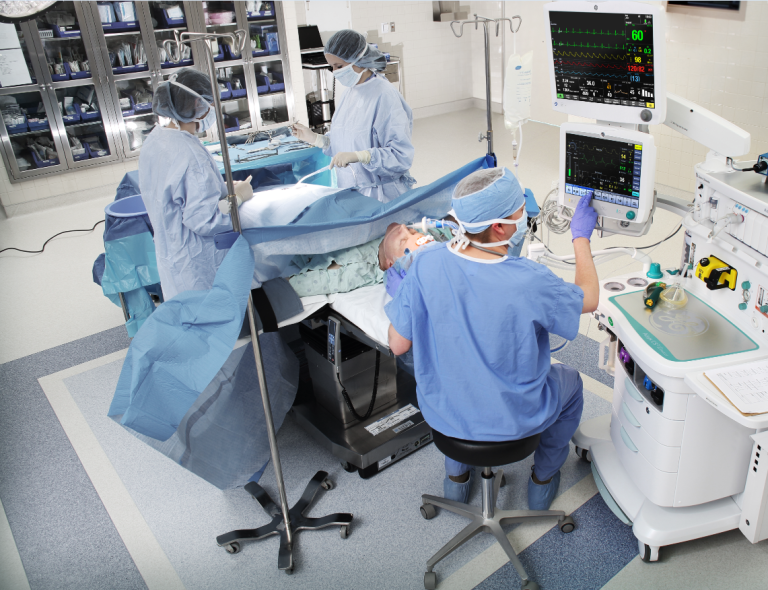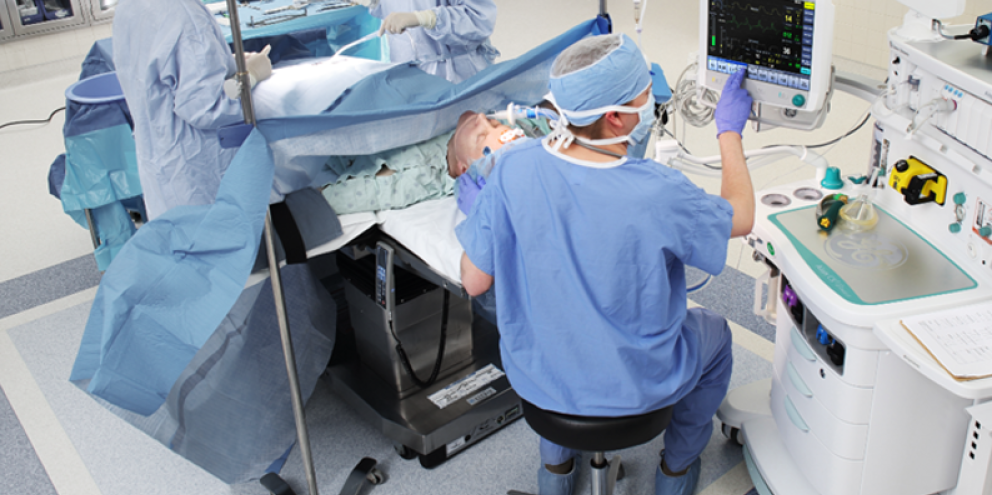
The surveys also reveal, however, that many anesthesia providers lack critical opportunities and incentives that could support their efforts to broaden utilization.
The two double-blinded surveys were commissioned by GE HealthCare and conducted independently by healthcare consultancy Sage Growth Partners in February and March 2024. Thefirst survey of 100 U.S.-based hospital and health system C-suite leaders was designed to evaluate the C-suite’s perceptions about the benefits of low flow anesthesia and their plans for low flow standardization in the next 1-2 years as an initiative to reach sustainability goals [1]. Thesecond survey of 215 U.S.-based anesthesiologists and CRNAs was created to learn more about the clinicians’ perspective on, and experience with, current low flow anesthesia practice and how automation may impact standard of care [2].
Overall, the surveys reveal:
- An increasing recognition of the value of low flow anesthesia among both the C-suite and anesthesia providers. Eighty-three percent of anesthesia providers and 68% of C-suite leaders believe broader adoption would reduce anesthesia costs; 74% of providers and 68% of C-suite leaders say it would improve environmental sustainability.
- A current low to moderate utilization rate of low flow anesthesia. Despite recognition of low flow benefits, utilization remains fairly low at many hospitals and health systems. Just 14% of the surveyed providers say low flow is administered in more than 90% of cases within their organization.
- A growing movement within hospitals and health systems to increase utilization. While the practice of administering low flow anesthesia has not yet achieved broad utilization, 51% of anesthesia providers say their organization is working to increase utilization, and 18% say their organization may consider doing so in the near future.
While the surveys indicate growing interest in low flow anesthesia, they also reveal that many organizations have yet to provide anesthesia providers with critical opportunities and incentives that could help support broader utilization of low flow techniques.
The Three Commonly Overlooked Opportunities and Incentives
Overlooked Opportunity #1: Only 27% of the surveyed providers say their organizations are using technology that indicates how much anesthetic agent is being consumed during procedures, as well as the associated costs.
Costs are both financial and environmental. Interest continues to build aroundhealthcare ESG progress [3], and there’s more general awareness around research showing that operating rooms generate three to six times as much carbon as the rest of health systems [4].Other data show that anesthetic gases alone contribute 51% of direct emissions for any general surgical procedure [5].
Despite the significant role that anesthetic gases have on the environment, the surveys show that nearly three-quarters of anesthesiologists and CRNAs don’t yet have access to technology that indicates anesthetic gas consumption during procedures. If indeed you can’t manage what you can’t measure, then healthcare organizations with limited visibility to empirical data may be leaving valuable opportunities to enhance environmental sustainability on the table.
One Massachusetts-based hospital system’s Sustainability Anesthesia Committee recently reduced its anesthesia-related carbon footprint by 75% over a two-year period by prioritizing education on environmental impact, while also monitoring and analyzing the carbon dioxide equivalents (KgCO2) with each anesthetic gas [6]. It’s hard not to infer that implementing similar "greener practice" education and monitoring approaches would contribute to lowered anesthetic waste, reduced carbon footprint and enhanced savings at other like-minded organizations.
Overlooked Opportunity #2: Only 8% of the surveyed providers say their organizations are using technology that automatically adjusts fresh gas flow concentrations to achieve and maintain established targets.
Provider burnout rates are at an all-time high – but for anesthesiology professionals specifically, it’s the highest among all medical specialties. Rates are approaching 40 percent, and are higher (52%) for those earlier in their career [7, 8].
The good news? Low flow automation innovations may reduce cognitive workload, potentially decreasing the risk of provider burnout.End-tidal Control* (Et Control) is a low flow automation technology that has been used in Europe for more than 10 years and was approved by the FDA in April 2022 after a U.S.-based, multi-center, multi-year clinical trial that included over 200 patients [9].
Over 80% of trial users said Et Control is easier to use than manual fresh gas control, and that it required fewer adjustments to obtain the desired result. Anesthesia providers can use Et Control to set targets for oxygen and anesthetic gases, and the software automatically and quickly achieves and maintains those targets with built-in safety features, so providers can practice automated low flow anesthesia with confidence. This greatly reduces the number of manual flow rate adjustments [10].
It’s time to adopt new ways of thinking—and operating—so perspectives are no longer “man versus machine,” but man working with machine. Low flow anesthesia has been a topic in medical schools for decades, but there’s still a lack of awareness around technology that could automate low flow administration. Eighty-one percent of the surveyed providers say such solutions would support broader practice of low flow anesthesia delivery; however, 64% are unaware that automated low flow anesthesia is already available.
Overlooked Opportunity #3: Only 14% of the surveyed providers say their organizations have tied quality or financial performance metrics to low flow anesthesia.
Let’s face it: healthcare organizations, especially hospitals, are operating on slimmer margins than ever before. That’s unlikely to change given the ongoing downward trend in reimbursement rates year over year for anesthesia services [11].
With decreased reimbursement rates, coupled with rising costs in personnel, supplies, and medications, it's paramount to consider cost-efficiency where possible. Investment around personnel and supplies is unlikely to decline, but reducing unnecessary medication spend and waste can ultimately impact financial performance. In fact, one evidence-based study predicted a 48% reduction in the cost of anesthetics after simulating a reduction of fresh gas flows from 2.5 liters per minute to 1 liter per minute [12].
As the number of elective surgeries like knee and hip replacements requiring anesthesia continues to rise—and the aging population along with it—there's tremendous potential to realize cost savings sooner rather than later [13]. Wrapping quality or financial performance metrics around low flow anesthesia utilization can have an outsized impact now and in the future. This is especially true when considering inhalational anesthetic agents.
Low Flow Anesthesia: A Glimpse into the Future
The increasing recognition of the benefits of low flow anesthesia, combined with the growing number of low flow anesthesia growth initiatives within hospital and health systems, indicates a significant shift in anesthesia administration may be on the horizon. In fact, more than 90% of the surveyed providers say low flow anesthesia is likely to become the “standard of care” within the next decade.
While this finding is compelling, the pace of the shift toward broader utilization of low flow anesthesia will be significantly impacted by the amount of support that anesthesia providers receive in navigating the change. Do they have access to technology that indicates how much anesthetic agent is being consumed during procedures? Do they have the opportunity to use technology that automatically adjusts fresh gas flow concentrations to achieve and maintain established targets? Do they receive incentives for their efforts associated with using low flow anesthesia more often? The hospitals and health systems that can answer “yes” to these questions will emerge as low flow anesthesia leaders, and will be among the first to experience the full environmental and cost savings benefits that will come from widespread utilization.
Sources:
[1] Double blinded GE HealthCare sponsored survey conducted independently by Sage Growth Partners in February and March 2024. 100 C-suite leaders participated in the surveyhttps://clinicalview.gehealthcare.com/market-report/why-low-flow-anesthesia-gaining-momentum
[2] Double blinded survey conducted independently by Sage Growth Partners in February and March 2024. 100 C-suite leaders participated in the survey
[3] ESG: Healthcare's new imperative, Modern Healthcarehttps://www.modernhealthcare.com/esg/esg-healthcares-new-imperative
[4] Operating rooms are the climate change contributor no one is talking about, American Association for the Advancement of Sciencehttps://www.eurekalert.org/news-releases/951971
[5] The impact of surgery on global climate: a carbon footprinting study of operating theaters in three health systems, The Lancet Planetary Healthhttps://www.thelancet.com/journals/lanplh/article/PIIS2542-5196(17)30162-6/fulltext
[6] Anesthesia Spotlight: How Mass General Clinicians Are Tackling Anesthetic Gas Emissions, Massachusetts General Hospitalhttps://www.massgeneral.org/anesthesia/news/anesthesia-spotlight-climate-change
[7] Burnout and Wellness: The Anesthesiologist’s Perspective, National Library of Medicinehttps://www.ncbi.nlm.nih.gov/pmc/articles/PMC7958220/#:~:text=Burnout%20in%20physicians%20and%20other,%2C%20with%20rates%20approaching%2040%25.
[8] Burnout Rate and Risk Factors among Anesthesiologists in the United States, American Society of Anesthesiologistshttps://pubs.asahq.org/anesthesiology/article/134/5/683/115466/Burnout-Rate-and-Risk-Factors-among
[9] Refer to GE Healthcare Et Control Pivotal Study Report DOC2163005.
[10]https://www.gehealthcare.com/products/anesthesia-delivery/aisys-cs2/end-tidal-control
[11] 2024 Medicare Physician Fee Schedule: Impact on Anesthesia, Anesthesia Business Consultantshttps://www.anesthesiallc.com/publications/anesthesia-provider-news-ealerts/1608-2024-medicare-physician-fee-schedule-impact-on-anesthesia
[12] Evidence-Based Project: Cost Savings and Reduction in Environmental Release With Low-Flow Anesthesia, American Association of Nurse Anesthetistshttps://pubmed.ncbi.nlm.nih.gov/33501906/
[13] Elective surgeries are on the rise: What does it mean for healthcare?, Advisory Boardhttps://www.advisory.com/daily-briefing/2023/06/21/surgery-volumes
*Et Control in the United States is indicated for patients 18 years of age and older.
Not all products or features are available in all markets.
JB29953XX
© 2024 GE HealthCare. GE is a trademark of General Electric Company. Used under trademark license.







